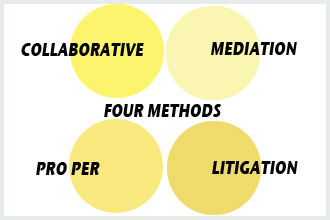Current research shows that when both parties contribute to the agreements, there is far less conflict that ensues after the divorce is finalized, greater compliance with the documents, and better, longer-lasting involvement with any children who are involved.
 Only you can determine which method is right for you. Remember, divorce is predominately an emotional process: it is imperative that you have a voice in establishing agreements if you are to feel a sense of fairness and control of your life–both now and in the future–and respect for yourself.
Only you can determine which method is right for you. Remember, divorce is predominately an emotional process: it is imperative that you have a voice in establishing agreements if you are to feel a sense of fairness and control of your life–both now and in the future–and respect for yourself.
Collaborative Divorce
Collaborative Divorce is a team approach to resolving the issues of divorce. The goal is to bring the spouses to mutual agreement around the issues of division of assets, support, child custody, etc. without the intervention of the court and without contest between attorneys.
It differs from mediation in that each spouse has legal representation and support throughout the process. The job of the team is to establish fair agreements that, ultimately, support the best interest of the family rather than the individual. Each spouse has both an attorney and a coach of their own. The coach is a licensed mental health professional.

If there are any children involved, there is a child specialist to represent the best interests of the children to the parents and the team. A financial planner is jointly used to determine the assets of the marriage.
Each of these professionals has had training in the Collaborative Divorce method and has usually worked with the other professional members before. Therefore, each spouse has a “team” working for and with them. The two spouses are involved in each step of the process and make all of their own decisions. The team helps them come to decisions and to develop a fair settlement agreement.
This is a “no” litigation process and prior to its start, all parties agree not to litigate the divorce. The attorneys prepare and file all the legal paperwork and since there is no litigation no court appearances are necessary for this process.
We recommend this process for spouses who want to put the best interest of the family or the relationship first while working through the divorce process, who want to develop settlement agreements and resolve issues without letting emotion undermine their decision-making or their sense of self, and who need support or guidance to do so.
Divorce Mediation in Texas
Mediation is a process where both spouses hire a mediator to help draft a marital settlement agreement. Both partners meet with the same mediator, usually at the same time. Lawyers specializing in family law, marriage and family therapists, psychologists, and clinical social workers serve as mediators, however, anyone trained in the process of mediation can be used.
The process is structured: several joint meetings are conducted during which division of property, child support, spousal support, etc., are addressed. At the initial meeting, the mediator explains the process and determines exactly what financial and personal information is needed and what documents must be obtained.
Later mediation meetings concentrate on determining the issues both spouses need resolved and helping the couple come to agreements that resolve them. The process is finished when both spouses are satisfied with the terms of the negotiation. Afterward, the mediator prepares the settlement document, the Petition for Dissolution, and other paperwork. There are no court appearances by either spouse, which minimizes costs. At any point in the process, either party can consult with an attorney of their choice to get advice regarding legal issues.
The mediator files legal paperwork, as necessary after it is reviewed by each individual’s attorney. We feel that mediation works best with couples who are not fighting, who are able to be unemotional, and who want the best for their former partner, now and in the future.
It is a process where both partners need to be able to sit down with each other and communicate without intimidation or being coerced into agreements they will regret later.
Pro Per
This is a divorce done without the representation of an attorney. You are representing yourself; your spouse is representing him/herself. You would go to the court, and obtain the necessary papers to fill out.
Both parties are responsible for filling out with honesty the financial assets and liabilities of the marriage so both know what resources or debts belong to the marriage and which belong to one spouse, solely.
Once you know what financial resources and liabilities exist, you and your spouse can work together to create a division of property, custody, alimony, and child support agreements.
Both of you would then file the documents with the court. You can use the services of a financial planner and an attorney to help you understand any financial or legal issue, or for advice. However, neither professional would represent you in court.
Some people use a paralegal service for obtaining the correct papers, for help filling them out, and for filing them. Some couples rely on how-to-do-it-yourself type of books for education.
This is probably a reasonable process for parties who can work well together, and who are able to keep strong emotions from interfering with their ability to think clearly and to problem solve.
It is not for parties who distrust each other, who are subject to strong emotion, or who want to secretly seek revenge. We do not recommend it in cases where there are complicated financial or custody issues.
Litigation
This is what most people recognize as the standard divorce process. In this case, each spouse has their own attorney representing them. Both attorneys are attempting to get the best possible financial deal and custody arrangement for their client, not the family as a whole.
It is seen in terms of winning or losing. Usually, there is little work that takes place with the spouses together. The process is largely controlled by the attorneys or the court. It is most often the most expensive type of divorce and can become the most acrimonious process.
We recommend this process in cases where spouses do not want to, or cannot, work together under any circumstances, or where one spouse is incapable of making complex decisions. It is frequently used by people who are unaware of the several other types of divorce process available to them.
This is also the process needed when two parties cannot come to a financial or custody agreement and the court must settle the dispute for them.
This process can create great emotional upheaval between spouses since they are communicating with each other through a third party which can feel very alienating. When the court has to make a decision to settle a dispute, neither party is in control of the outcome.